Scoping Out Customization at the New Balance Factory
From the 998s to brand new NB1 3000v3 baseball cleats

Stepping onto the production floor of New Balance‘s Lawrence, MA factory reveals two important pillars of the brand. First, they employ hundreds of skilled workers from Lawrence and the surrounding towns to produce footwear stateside. Second, customization really is done by hand—at times by hand on technologically advanced machines, but hands touch every step of the process. Not all New Balance sneakers are made in America, but they do produce four million pairs of athletic footwear per year here and that can’t be said for many other brands at their level. And while we were there, just prior to the launch of the brand new NB1 3000v3 baseball cleat, it seemed like almost half of the production floor was dedicated to making the new product a reality.

In the factory, we bore witness to everything from sewing and stitching to sole laying. Every step along the way is carefully overseen by the individual or team enacting it. There’s really nothing quite so impressive in a shoe factory than seeing a two-dimensional upper cut-out get folded and stitched in order to produce a three-dimensional body. Faulty products are caught and fixed up until the sole is added. Prior to that, anything can be cut off or re-stitched. The sole, however, seals the deal. Around the factory floor, teams work on assembly lines and understandably admit that they like working on larger orders of the same shoe. Smaller orders or one-offs do require the shifting of equipment, switching out materials and frequent disruption.

One of the most impressive levels of the New Balance factory happens to be their research lab and testing facility. It opened in 2008 and incorporates a lot of field of play activity—meaning footwear for training and lacrosse, baseball and more is tried out on the surface it will be used on once the sneaker leaves the factory. Pedro Rodrigues, the Sports Research Manager and head of the division, explains, “We did a lot of running research right from the get-go. But as we started on different projects for training, baseball, etc, we starting adding more bodies.” The staff grew and their equipment advanced. The camera systems sense infrared light, which allows the team to track movement from segments of the body. Coupled with a force plate, they can analyze weight shifts many thousands of times every second and how that corresponds to the footwear. Tangible data and developments from the research lab, about New Balance sneakers and even competitors, then make their way back to product development.

Prior to our factory tour, we spent time designing our own New Balance 998s. There’s definitely a retro styling to the shoe—in that, it looks (and feels) like exactly what you’d expect from the brand. The silhouette is now iconic. And while there are millions of variations available through the multiple customization options, it’s equally important that the website and UI are incredibly easy to navigate. If one wanted, they could manifest their vision in a handful of minutes. Most people who go down that path, however, take far longer to make sure everything is just as they wish.

For their first run, all of the NB1 3000v3 cleats will be produced stateside. That’s a big deal as the turnaround is only two weeks or less—for complete customization. That’s 16 different areas that allow for personalization (including mesh and suede, colorways, and an embroidered number). All of that is then built by hand. The cleat itself was already well-received and the open door for a custom product will benefit teams and individuals, whether they’re looking to appear unified yet distinct, or entirely out there.
You can design your own NB1 3000v3 online for $148, or the unisex New Balance 998 for $190.
Images by Mike Carozza of WhatProsWear












